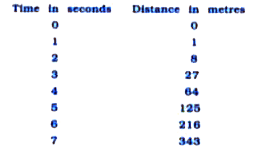A sphere of mass 4kg, moving with velocity 5 ms−1 collide with another sphere of mass 2 kg moving with velocity 2 ms−1 in the same direction on linear path. After the collision the first sphere is moving in the same direction with velocity 3 ms−1. What would be the velocity of the second sphere after collision? Solution in Gujrati
6 ms−1 in the direction of initial motion
Topper's Solved these Questions
- FORCE AND LAWS OF MOTIONBOOK - KUMAR PRAKASHANCHAPTER - FORCE AND LAWS OF MOTIONEXERCISE - Question based on pracctical skill with answers(Select the appropriate option and complete the sentence :)
4 Videos
- FORCE AND LAWS OF MOTIONBOOK - KUMAR PRAKASHANCHAPTER - FORCE AND LAWS OF MOTIONEXERCISE - Additional Exercise
4 Videos
- GRAVITATIONBOOK - KUMAR PRAKASHANCHAPTER - GRAVITATIONEXERCISE - ACTIVITY 10.4
2 Videos
Similar Questions
Newton's II law of motion connects:
View SolutionThe following is the distance-time table of an object in motion:

(a)What conclusion can you draw about the acceleration ?Is it constant. Increasing decreasing ir zero? (b)What do you infer about the force acting on the object?
View SolutionTake an empty plastic bottle . Close the mouth of the bottle with an airtight stopper . Put it in a bucket filled with watere . The bottle floats .
Push the bottle into the water. You feel an upward push. Try to push it further down. You will find it difficult to push deeper and deeper. Water exerts a force on the bottle in upward direction. Now release the bottle. It bounces back to the surface.
Does the force due to the gravitational attraction of the earth act on this bottle? If so, why doesn't the bottle stay immersed in water after it is released ?
View SolutionA sphere of mass 'm' moving with velocity 'v' collides head-on on another sphere of same mass which is at rest. The ratio of final velocity of second sphere to the initial velocity of the first sphere is (e is coefficient of restitution and collision is inelastic)
View SolutionA spere of mass 20 kg moving with a velocity 40ms−1 collides with another sphere of mass 15 kg which is at rest . After collision they move with the same velocity . Find the velocity .
View SolutionA sphere of mass m moves with a velocity 2v and collides inelastically with another identical sphere of mass m. After collision the first mass moves with velocity v in a direction perpendicular to the initial direction of motion . Find the speed of the second sphere after collision .
View SolutionA sphere of mass 2 kg moving with a velocity collides elastically with another sphere which is at rest. If after the collision, the first sphere moves in the same direction with its velocity reduced to one third of its initial velocity, find the mass of the second sphere.
View SolutionTwo perfectly elastic spheres of masses 2 kg and 3 kg moving in opposite directions with velocities 8ms−1and6ms−1 respectively collide with each other. Find their velocities after the impact.
View SolutionA sphere of mass 50xx10^(-3) kg moving with a velocity of 2ms^(-1) hits another sphere which is at rest. Assuming the collision to be head - on collision and if they stick together after collision and move in the same direction with a velocity of 0.5 ms^(-1) , find the mass of the second sphere.
View SolutionTwo spheres A and B moving in opposite directions have velocities of 10 ms^(-1) and 20 ms^(-1) . The two spheres collide with each other elastically. If A continues to move in the same direction at 4 ms^(-1) , the velocity of sphere B just after the collision is
View SolutionTwo perfectly elastic spheres of masses 2 kg and 3 kg moving in opposite directions with velocities 8 ms^(-1) and 6 ms^(-1) respectively collide with each other. Find their velocities after the impact.
View SolutionA sphere of mass 2 kg moving with a velocity collides elastically with another sphere which is at rest. If after the collision, the first sphere moves in the same direction with its velocity reduced to one third of its initial velocity, find the mass of the second sphere.
View SolutionA sphere of mass 2 kg moving with a velocity of 40 ms^(-1) hits another sphere which is at rest. After the collision, they move together with a velocity of 25 ms^(-1) in one direction. Find the mass of the second sphere.
View SolutionA sphere of mass 3 kg moving with a velocity of 2 ms- collides head-on with another sphere of mass 4 kg moving in opposite direction with a velocity of 1 ms. After collision if they stick together and move with a velocity v, find (i) the total initial momentum and (ii) the value of velocity v.
View SolutionA sphere of mass 2 kg moving with a velocity collides elastically with another sphere which is at rest. If after the collision, the first sphere moves in the same direction with its velocity reduced to one third of its initial velocity, find the mass of the second sphere.
View SolutionA sphere of mass 50 xx 10^(-3) kg moving with a velocity of 2 ms^(-1) hits another sphere which is at rest. Assuming the collision to be head - on collision and it they stick together after collision and move in the same direction with a velocity of 0.5 ms^(-1) , find the moss of the second sphere
View Solution
